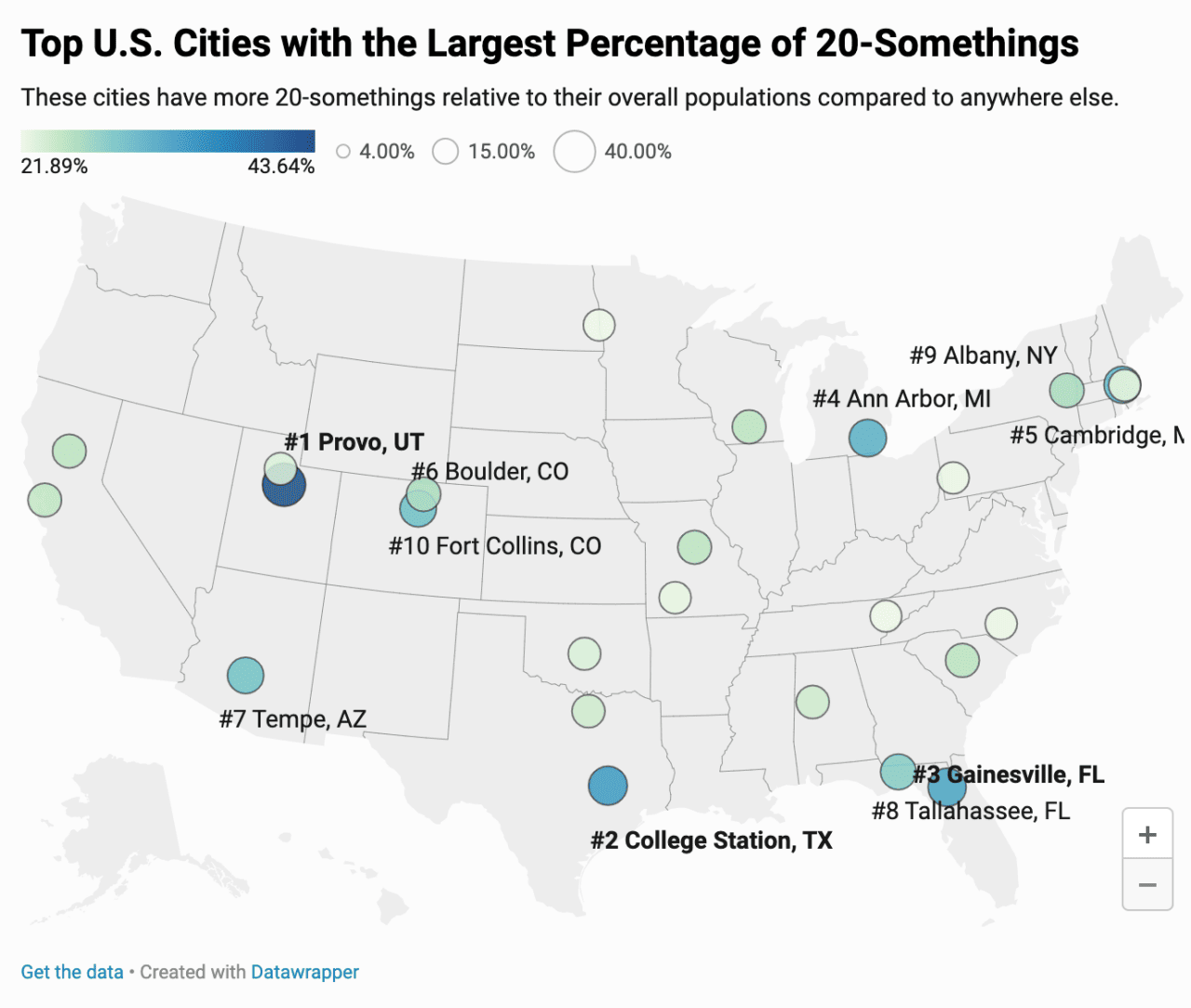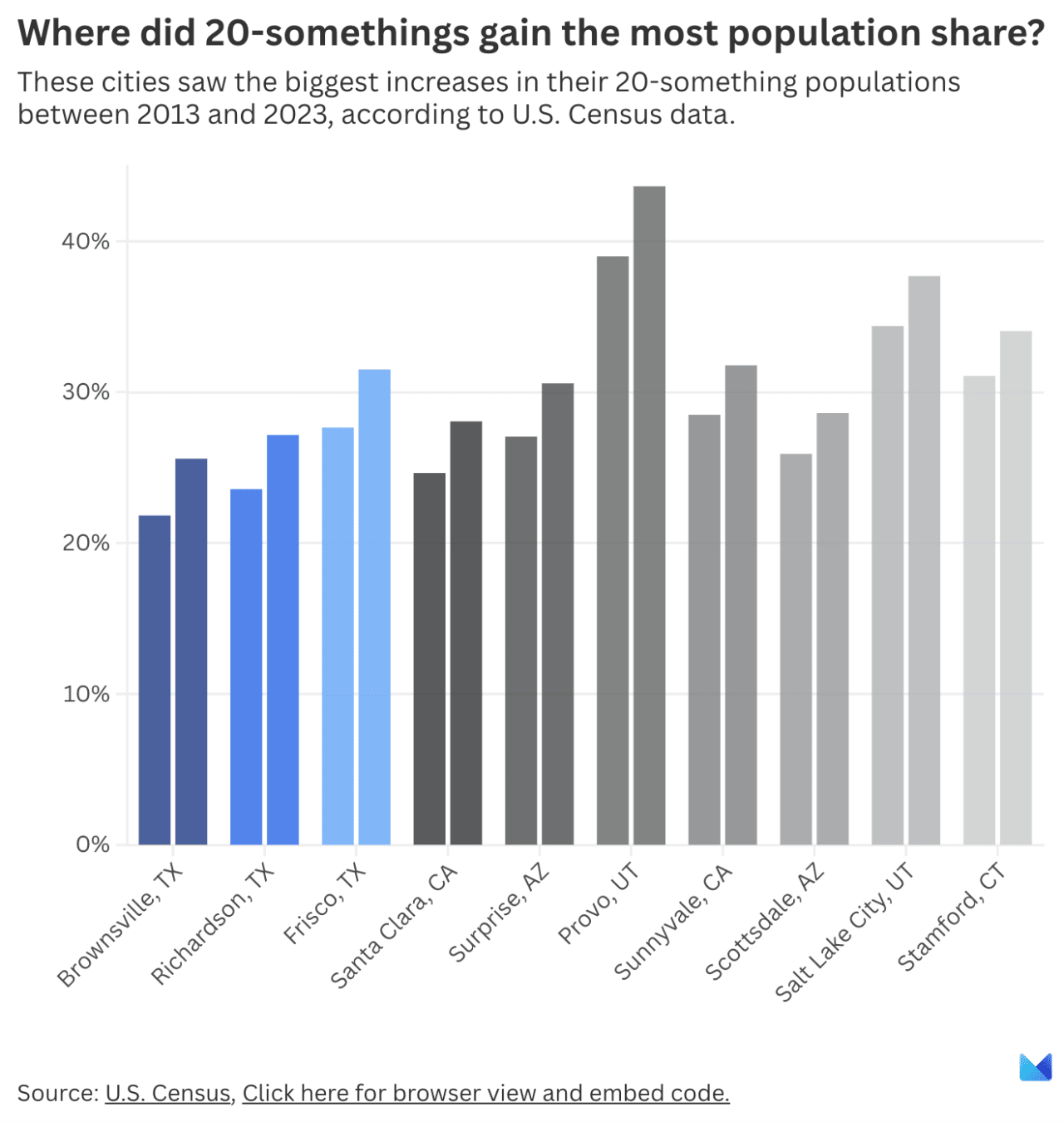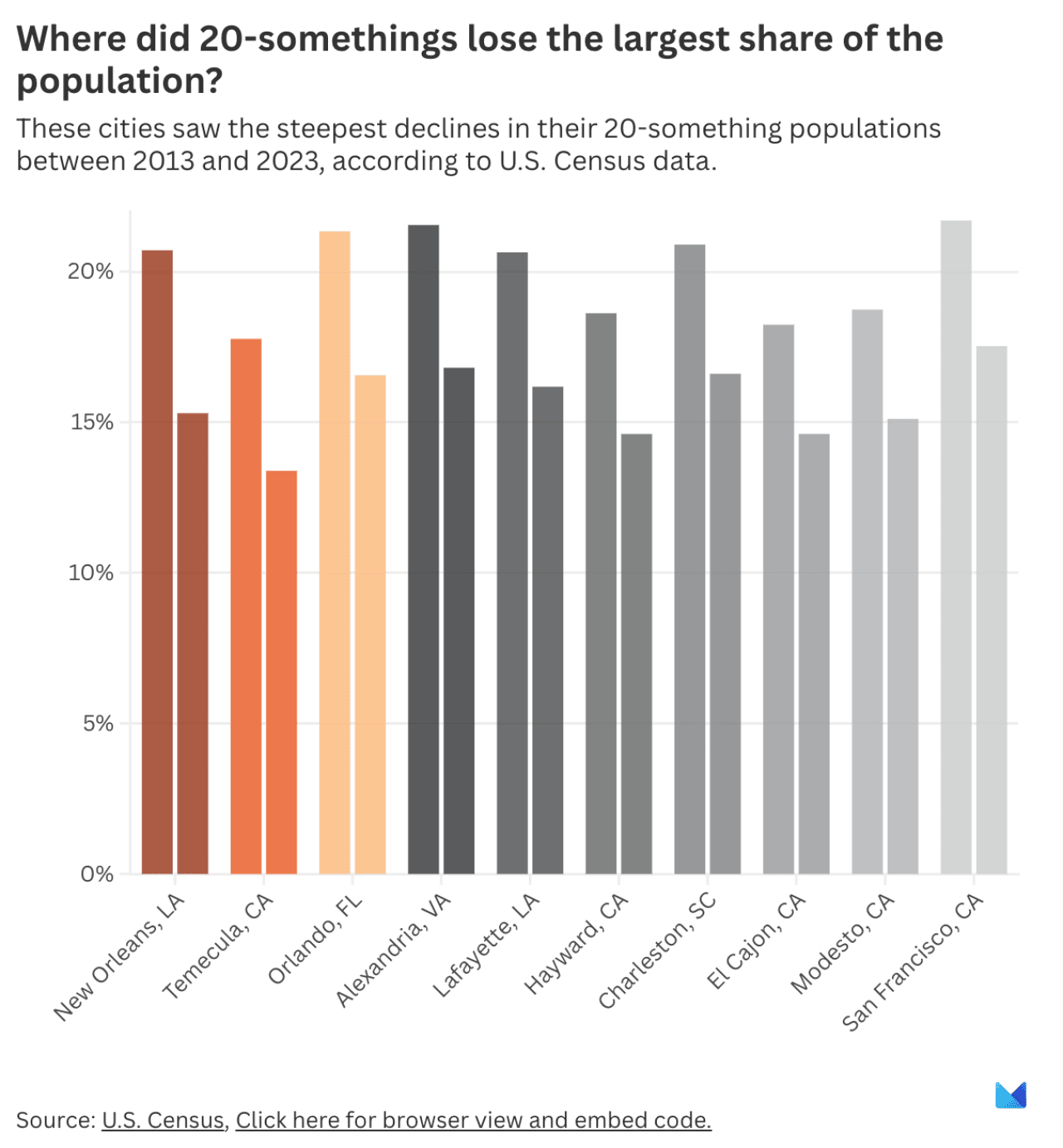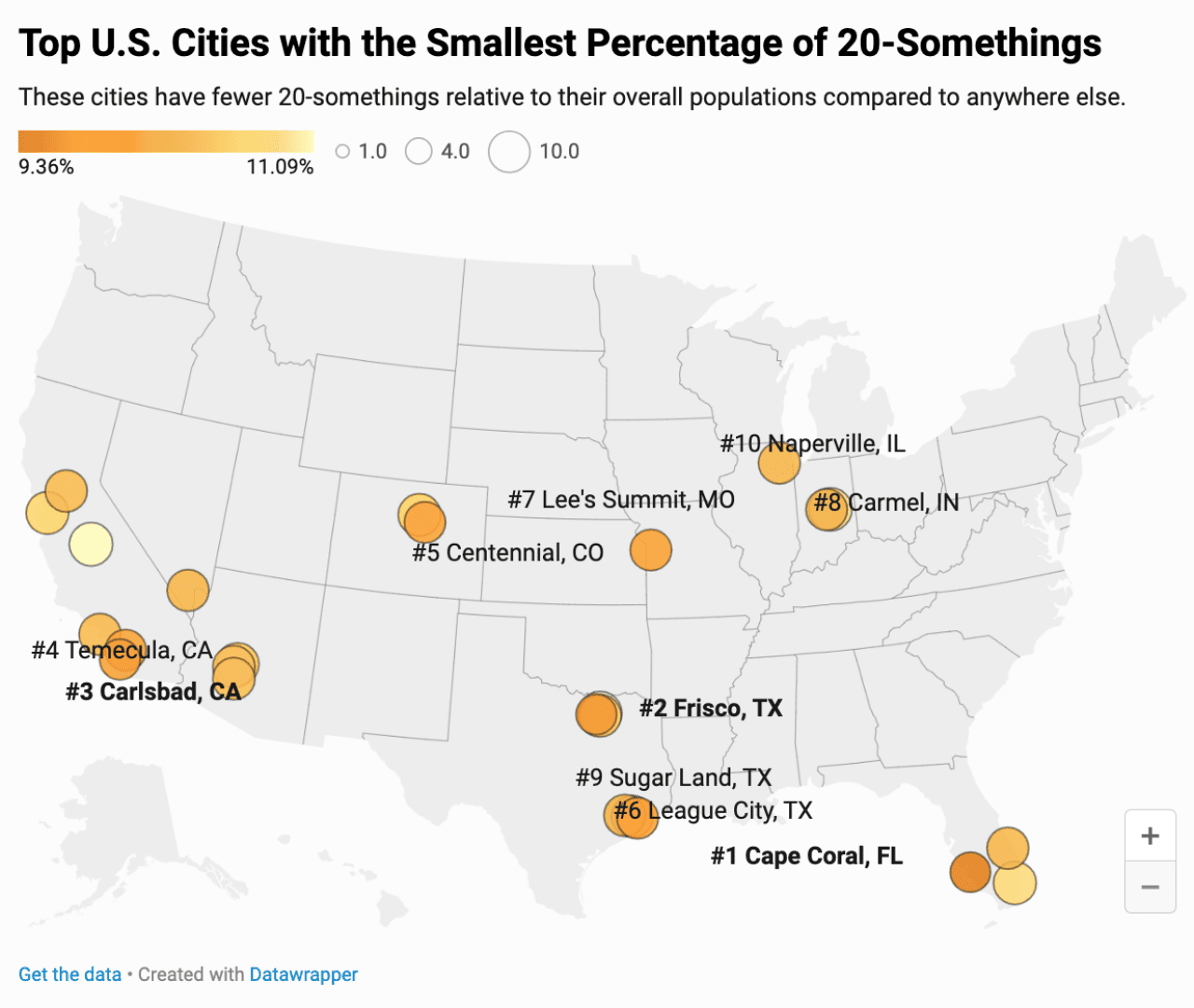Today’s 20-somethings can find it hard to fit in: They’re notoriously left off the real estate ladder and may struggle to afford housing, get a foot in the door of their careers, and uncover vibrant dating scenes to help them land the partner of their dreams.
Where can they thrive?
We wanted to know which cities 20-somethings are most likely to call home — the places likely to be friendliest to new grads navigating the rapids of their new adult lives.
So, moveBuddha analyzed U.S. Census data, then calculated the percentage of 20-29-year-olds in every U.S. city with a population over 100K.
Where are America’s most popular cities for 20-somethings?

Today’s 20-something Meccas are most often right where the country’s 22-year-olds graduated, did internships, and put down roots: in their college towns. But that’s not surprising. Which college towns rise to the top and are best at enticing grads to stay well into their 20s is more interesting.
#1 Provo, Utah, caters to 20-somethings. It ought to – they’re 44% of the population. However, college enrollment isn’t the only driver. Though the Census counts juniors and seniors (as well as graduate students) who are likely in their 20s and who reside in dorms or other temporary collegiate digs most of the year as residents, Provo is still notable:
Maybe it’s not just the student culture of this university town that catapults it to the #1 spot.
Provo does have a large base of students, but it also boasts scads of new graduates who stay put, perhaps drawn to a growing job and construction-forward housing market. They become magnets for yet more graduates, all reinforcing Provo’s position as the country’s capital of the 20-something crowd.
Other college towns take the lion’s share of young adults well into their 20s. The top 10 are all widely recognized as college towns where higher education shapes the local economy. #2 College Station, Texas, sees ~73K students flood its streets every fall, nearly matching the city’s 128K total residents.
#3 Gainesville, Florida, has ~57.8K students in a city of 144K. It’s a massive ratio, and the university’s many large graduate programs, like business, engineering, medicine, and law, keep plenty of 20-somethings near campus.
To get off campus, you’d have to visit 20-something city #15, Salt Lake City. With 27.65% of its residents in their 20s, it’s a reflection of Utah’s Mormon roots: The state sports a young population due to multiple large families, and an economy that branches beyond higher education.
With 14.57% of its population being 20-somethings, Brownsville, Texas, was in 95th place 10 years ago. Today, Brownsville now ranks 20th, with its share of 20-somethings increasing by 27.71% over the decade. The SpaceX outpost was fast amassing 20-somethings even before launches came to town.

That growth and any new tech opportunities that come to Brownsville may accelerate the trend. As the top 20-something growth cities suggest, high employment growth and high growth among 20-somethings are entwined.
For instance, Richardson, Texas; Santa Clara, California; Sunnyvale, California; Stamford, Connecticut; and Scottsdale, Arizona, are all located in major employment hubs. They encircle places like Dallas, Silicon Valley, Phoenix, and New York City, which helps them pull in young professionals from across the country.
Further, states like Utah and Texas are high-growth in and of themselves, with Texas making headlines as a Gen Z destination, and Brownsville trending as a top inbound destination. These broader growth trends mean that young workers are likely to find compatriots moving to popular cities and begin building networks into the social fabric of these growing cities, spurring further growth.
In other words, where state growth and job development coincide, the 20-something population share takes off. Take Brownsville, dubbed an emerging tech hub based on growth from 2018 to 2023, or Scottsdale with its top job market. Both are now on the top 10 list for the highest percentage of 20-something residents.

As in the top inbound cities, overall growth trends are tied to 20-somethings saying goodbye to American cities. Between 2018 and 2023, New Orleans lost about 7% of its population, but that number skyrocketed to 31% among 25-29-year-olds.
However, strangely, many of these cities are in the U.S. South, an area synonymous with runaway growth over the past five years.
That means these cities aren’t losing young people because the region overall is losing ground. Instead, these spots may be finding their young people leaving for suburbs, exurbs, and small metros, all of which are leading Southern growth.
So in Orlando, Florida, outer suburbs like Lake Nona and Clermont, with growth over 12% in recent years, are still winning while the inner city’s population declines. In Charleston, South Carolina, Mount Pleasant or Summerville may be supplanting the urban core.
Other top 20-something losers are places in popular metros or regions where career-starters can’t get a foot in the door, like Temecula, California; Alexandria, Virginia; or San Francisco.

While the college towns that dominate the 20-something landscape are scattered across the map, there’s less diversity in the cities where 20-somethings fear to tread.
They’re often either retirement havens or suburbs known for their safe and sleepy reputations and unaffordable price tags, spots that tend to attract mid-career professionals, not young grads.
In fact, every city in the top 10, except for Cape Coral, Florida, comes with average home values above the U.S. as a whole. As a group, they average 64% above the national average, making them less accessible to career starters.
In #2 Carlsbad, California, newcomers can expect to pay over $1.2 million for an average home. And even #10 Naperville, Illinois, is an affluent, family-oriented Chicago suburb where the average house is more than 10X the average entry-level marketing salary in the Chicagoland area. It’s a place where 20-somethings won’t be renting either: The average rent of $2,522 is about 66% the take-home of that marketing salary.
While some cities with low numbers of young adults are in high-growth states, like Texas, their growth is fueled by older adults rather than entry-level job growth and streets teeming with excitement and new grads.
While overall migration growth typically attracts young people, that’s not true for these cities. They find that popularity alone isn’t enough to attract young adults.
Across the country, the most popular cities for 20-somethings are college towns like Ann Arbor, Michigan; and Provo – university hubs with large grad programs and lots of early-career opportunities nearby.
But they’re also career super-starters like Richardson, Texas, and Sunnyvale, California, where young adults can take a swing at winning professional and tech jobs.
At the other end of the spectrum, 20-somethings are exiting cities and avoiding suburbs where mid-career earners are pricing them out or where growth is stagnant and jobs are drying up. Some of those cities are thriving, but as young people increasingly ask, “For whom?” they’re looking to find their own fortunes in the familiar university towns that have long had their backs.
20-somethings aren’t retreating to familiarity in a place with cheap pizza and pints. They’re simply asking whether their first adult communities can sustain them as they begin building their careers. The winners? The cities that combine growth with jobs and affordable housing. Those places just happen to come with a bumper crop of new teen neighbors every fall, too.
moveBuddha mined S0101 U.S. Census tables, which offer age data for all locations in the U.S. We then transformed that data in order to see a percentage of people aged 20-29 in any given place, effectively comparing both large and small populations equally against a single yardstick.
Finally, moveBuddha ranked and tracked data across a 10-year period.
This story was produced by moveBuddha and reviewed and distributed by Stacker.
Reader Comments(0)